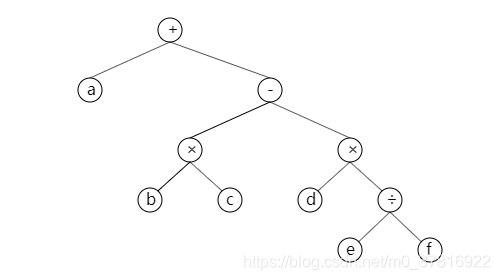用C语言写一个计算器,除了四则混合运算之外,还支持三角函数和绝对值等函数。
PS E:\Code\PL\calc>.\a.exe
abs(3*5-4^2)abs(3*5-4^2)=1.00000025-7+6*(4-5)25-7+6*(4-5)=12.000000
文章目录
在计算器中,至少包含两类变量,即数字和运算符。例如,如果希望实现
a
+
b
×
(
c
−
d
)
a+b\times (c-d)
a+b×(c−d)这样一个简单的功能,要求编译器可以识别出
+
,
×
,
−
,
(
,
)
+,\times,-,(,)
+,×,−,(,)这五个符号,并理清彼此的计算顺序,最后生成一棵语法树,然后实现输出。
1. 加减法运算
万事开头难,所以我们选择一个简单到无脑的开头。首先,我们考虑实现
a
+
b
a+b
a+b这样简单的两数运算,即如下所示,十分简单且无脑。
voiddouCalc(){while(1){double i, j, s;char k;scanf("%lf%c%lf",&i,&k,&j);switch(k){case'+':
s = i+j;break;case'-':
s = i-j;break;case'*':
s = i*j;break;case'/':
s = i/j;break;default:break;}printf("%lf\n", s);}}
然后,我们考虑,如何实现一个连加器,旨在解决
a
+
b
+
c
+
.
.
.
a+b+c+...
a+b+c+...的计算问题。这里虽然不涉及到运算次序,但仍旧需要处理多个不确定个数的变量,所以我们不再可以直接用类似
scanf("%lf%c%lf", &i, &k, &j);
的方案来实现数据的输入,而必须建立一个链表来存储变量。
C语言输入输出
在C语言中,可以通过至少三种方式来读取键盘输入的值:
scanf():和 printf() 类似,scanf() 可以输入多种类型的数据。getchar()、getche()、getch():这三个函数都用于输入单个字符。gets():获取一行数据,并作为字符串处理。
其中,
scanf
是格式化扫描的意思,可以通过格式控制符对输入字符进行格式化,并赋值给相关变量。
格式控制符说明%c读取单一字符%s读取一个字符串(以空白符为结束)%f、%lf读取十进制形式小数,赋值给float、double 类型%e、%le读取指数形式小数,赋值给 float、double 类型%g、%lg读取十进制或指数形式的小数,
并分别赋值给 float、double 类型
- 整数格式化 shortintlong十进制%hd%d%ld八进制%ho%o%lo十六进制%hx%x%lx无符号%hu%u%lu
getchar()
等价于
scanf("%c", c)
,相对来说更加简单。
getche
和
getch
是Windows独有的函数,在头文件
conio.h
中故不赘述。
gets
和
scanf(%s,s)
的区别在于,后者在使用的过程中会把空格当作终止符,而前者不会。
所以,我们在实现连加的过程中,会使用
gets
作为交互方法。
由于我们实现的是一个连加器,所以输入字符中只包含数字和加号,那么接下来,我们需要遍历输入字符,通过加号来将数字分开。我们可以很方便地写下一个简单而丑陋的小程序。
voidadds(){char str[100];char numStr[20];int num[20];int val;int i,j,k;while(1){gets(str);
i =0;j =0;k =0;while(str[i]!='\0'){if(str[i]=='+'){
num[k]=atoi(numStr);
k++;
j =0;}else{
numStr[j]= str[i];
j++;}
i++;}
num[k]=atoi(numStr);
val =0;for(int i =0; i < k+1; i++){
val += num[i];}printf("%d\n",val);}}intmain(){adds();return0;}
由于加减法具有相同的运算优先级,在实现上不过是为后续的数字加上一个负号而已,故可十分方便地在原有程序上修改。
此外,
adds
代码乍看上去没什么问题,但
str
的值在更新之前,并不会自动清零,由此带来的bug需要创建一个字符串清零的函数。修改之后的代码如下
#include<stdio.h>#include<stdio.h>#include<string.h>#include<math.h>voidstrClear(char*str,int n){for(int i =0; i < n; i++){
str[i]=NULL;}}voidadds(){char str[100];char numStr[20];int num[20];int val;int i,j,k;while(1){gets(str);
i =0;j =0;k =0;while(str[i]!='\0'){if(str[i]=='+'){
num[k]=atoi(numStr);strClear(numStr,20);
k++;
j =0;}elseif(str[i]=='-'){
num[k]=atoi(numStr);strClear(numStr,20);
k++;
numStr[0]= str[i];
j =1;}else{
numStr[j]= str[i];
j++;}
i++;}
num[k]=atoi(numStr);strClear(numStr,20);
val =0;for(int i =0; i < k+1; i++){
val += num[i];}printf("%d\n",val);}}intmain(){adds();return0;}
精简一下
#include<stdio.h>#include<stdio.h>#include<string.h>#include<math.h>voidstrClear(char*str,int n){for(int i =0; i < n; i++){
str[i]='\0';}}voidadds1(){char str[100];char numStr[20];int i,j,val;while(1){gets(str);
i =0;j =0;val =0;while(str[i]!='\0'){if((str[i]=='+')||(str[i]=='-')){
val +=atoi(numStr);strClear(numStr,20);
j =0;if(str[i]=='-')
numStr[j++]=str[i];}else
numStr[j++]= str[i];
i++;}
val +=atoi(numStr);strClear(numStr,20);printf("%d\n",val);}}intmain(){adds1();return0;}
2. 加法和乘法
若希望加入乘法和除法,那么修改代码的过程就相对复杂了,因为乘除法在运算过程中,具有比加减法更高的优先级。那么我们就无法通过一个简单的数组来存储变量,而必须建立一种树形的结构。
例如,对于
a
+
b
×
c
−
d
×
e
/
f
a+b\times c-d\times e/f
a+b×c−d×e/f,可写成如下形式
[外链图片转存失败,源站可能有防盗链机制,建议将图片保存下来直接上传(img-ruufs0c0-1608717185925)(img/calc1.png)]
我们可以看到,这是一个二叉树,每个叶节点都是数字,而两个叶节点的父节点则为运算符。我们通过这个运算符来计算其子节点后,删除它的两个子节点,同时运算符所对应的节点退化为叶节点,同时其类型也变为数字。
对于上图而言,先计算
e
/
f
e/f
e/f,然后计算
b
×
c
b\times c
b×c和
d
×
e
/
f
d\times e/f
d×e/f,再计算
b
×
c
−
d
×
e
/
f
b\times c-d\times e/f
b×c−d×e/f,最后计算最上面的加法。
对于树来说,我们的遍历往往从根节点开始,所以其计算规则如下:
- 如果当前节点的子节点为叶节点,则计算当前节点,并删除该节点的叶节点,然后考虑其父节点。
- 如果当前节点的某个子节点不是叶节点,则处理该子节点,直到该子节点成为叶节点为止。
- 如果当前节点为根节点,且为叶节点,则输出计算结果。
对于节点来说,除了父子节点外,则至少有两个属性:
- isLeaf:用于叶节点判定。在这里,叶节点不仅有结构上的意义,更有着明确的语义:它只能是数字。
- value:对于叶节点而言,这个值为数字,否则的话,这个值为运算符号及其所对应的计算规则。
#defineMAXLEN100typedefstructNODE{structNODE*father;structNODE*Left;structNODE*Right;char value[MAXLEN];int isLeaf;}Node;
生成计算树
由于我们规定了两个运算层级,所以再遍历字符串以生成计算树的过程中,需要两次循环,即首先生成加减法的计算树,然后再生成乘除法的计算树。
生成计算树的过程可以简化为字符串不断拆分的过程,为了简化思维,我们只考虑两个符号
+
和
*
,这两个符号分别代表两种计算层级。
由此可得到如下代码。对于
#defineTRUE1#defineFALSE0voidnewNode(Node *root, Node *father){
root -> father = father;
root ->Left =NULL;
root -> Right =NULL;
root -> isLeaf = FALSE;}//root 为根节点,str为字符串voidinitCalcTree(Node *root,char flag){for(int i =0; i < MAXLEN; i++){if(root->value[i]==flag){
Node *Left =(Node *)malloc(sizeof(Node));
Node *Right =(Node *)malloc(sizeof(Node));newNode(Left,root);newNode(Right,root);for(int j =0; j < i; j++)
Left -> value[j]= root->value[j];
Left->value[i]='\0';
i++;for(int j = i; j < MAXLEN; j++)
Right -> value[j-i]= root->value[j];
root->Left = Left;
root->Right = Right;strClear(root->value,MAXLEN);
root->value[0]= flag;
root->value[1]='\n';initCalcTree(Left,'*');if(flag=='+')initCalcTree(Right,'+');elseinitCalcTree(Right,'*');break;}else{if(root->value[i]=='\0'){if(flag =='+')initCalcTree(root,'*');else
root -> isLeaf = TRUE;break;}elsecontinue;}}}
测试一下
voidprintNode(Node *root,int start){printf("the %dth node is %s\n", start, root->value);if(root->isLeaf==FALSE){printNode(root->Left, start +1);printNode(root->Right, start +1);}}intmain(){
Node *root =(Node *)malloc(sizeof(Node));char*str ="1+21*3+3*4*5+6";strcpy(root->value,str);initCalcTree(root,'+');printNode(root,0);return0;}
得到结果为
the 0th node is +
the 1th node is 1
the 1th node is +
the 2th node is *
the 3th node is 21
the 3th node is 3
the 2th node is +
the 3th node is *
the 4th node is 3
the 4th node is *
the 5th node is 4
the 5th node is 5
the 3th node is 6
然后,我们再对计算树进行计算。当被计算的量为叶节点时,则返回该节点的值;如果该节点的两个节点都是叶节点,则返回该节点处的运算符对这两个子节点的计算值;如果该节点的两个节点都不是叶节点,那么对这两个子节点进行计算。
intcalcNode(Node *root){if(root->isLeaf == TRUE)returnatoi(root->value);elseif(root->Left->isLeaf * root->Right->isLeaf == TRUE){if(root->value[0]=='+')returnatoi(root->Left->value)+atoi(root->Right->value);elseatoi(root->Left->value)*atoi(root->Right->value);}else{if(root->value[0]=='+')returncalcNode(root->Left)+calcNode(root->Right);elsereturncalcNode(root->Left)*calcNode(root->Right);}}intmain(){
Node *root =(Node *)malloc(sizeof(Node));char str[MAXLEN];while(1){gets(str);strcpy(root->value,str);initCalcTree(root,'+');printf("%s=%d\n",str,calcNode(root));}return0;}
结果为
PS E:\Code\PL\calc>.\a.exe
1+2+3*4+15*21+2+3*4+15*2=452*5+3*6*122*5+3*6*12=226
3. 四则混合运算
如果考虑加减乘除,那么意味着一个运算级别下有多种运算符,所以我们需要通过一个函数来返回运算符的运算次序。
intgetOrder(char ch){int result;switch(ch){case'+':case'-':return0;case'*':case'/':return1;default:return2;}}
然后,基于此,修改计算树的生成与计算代码。
intdouCalc(char c,int a,int b){switch(c){case'+':return a+b;case'-':return a-b;case'*':return a*b;case'/':return a/b;}}voidnewNode(Node *root, Node *father){
root -> father = father;
root ->Left =NULL;
root -> Right =NULL;
root -> isLeaf = TRUE;
father -> isLeaf = FALSE;}//root 为根节点,str为字符串,N为字符串长度voidinitCalcTree(Node *root,int order){for(int i =0; i < MAXLEN; i++){if(getOrder(root->value[i])==order){
Node *Left =(Node *)malloc(sizeof(Node));
Node *Right =(Node *)malloc(sizeof(Node));newNode(Left,root);newNode(Right,root);for(int j =0; j < i; j++)
Left -> value[j]= root->value[j];
Left->value[i]='\0';
i++;for(int j = i; j < MAXLEN; j++)
Right -> value[j-i]= root->value[j];
root->Left = Left;
root->Right = Right;
root->value[0]= root->value[i-1];
root->value[1]='\0';initCalcTree(Right,order);if(order<1)initCalcTree(Left,order+1);break;}elseif((i==0)&&(order<2))initCalcTree(root,order+1);}}intcalcNode(Node *root){if(root->isLeaf == TRUE)returnatoi(root->value);elseif(root->Left->isLeaf * root->Right->isLeaf == TRUE)returndouCalc(root->value[0],atoi(root->Left->value),atoi(root->Right->value));elsereturndouCalc(root->value[0],calcNode(root->Left),calcNode(root->Right));}intmain(){
Node *root =(Node *)malloc(sizeof(Node));char str[MAXLEN];while(1){gets(str);strcpy(root->value,str);initCalcTree(root,0);printf("%s=%d\n",str,calcNode(root));}return0;}
至此,我们得到了一个计算器的“骨架”,为运算符设定相应的运算次序,相当于提供一种生成方法,这种方法可以直接扩展到更多的运算符上。
同时,上述代码中也出现了两个问题:
- 我们默认计算的是整型数据,所以无法处理浮点型运算
- 减法和除法虽然在名义上与加法、乘法处于相同的运算次序中,但我们的生成树中默认的是从右向左计算。对于 a + b − c + d a+b-c+d a+b−c+d这样的表达式,会计算成 a + b − ( c + d ) a+b-(c+d) a+b−(c+d)的形式,这是错误的。
针对这种运算结构的一个优势和两个问题,我们继续改进这个计算器程序。
4. 浮点型计算器程序
首先,我们将所有函数与变量均改为
double
类型;然后我们更改输入字符串的遍历方式,从后向前进行遍历。
我们再加入乘方运算符
^
,给它一个更高的运算层级
intgetOrder(char ch){int result;switch(ch){case'+':case'-':return0;case'*':case'/':return1;case'^':return2;case'0':case'1':case'2':case'3':case'4':case'5':case'6':case'7':case'8':case'9':return3;default:return4;}}doubledouCalc(char c,double a,double b){switch(c){case'+':return a+b;case'-':return a-b;case'*':return a*b;case'/':return a/b;case'^':returnpow(a,b);}}
至此,我们写出了一个可以计算
+-x÷^
的程序。但我们还不能处理表达式中可能出现的括号。
括号在表达式中成对出现,故不同于常规运算符,需要在表达式的两端进行遍历;另外,括号不具备运算功能,只有规定运算次序的作用,对于括号运算符只有一个子节点。所以,只需更改
initCalcTree
的代码。
由于我们将算法改为从右向左遍历,所以如果最后一个字符不是
)
,则不必考虑括号的影响。当最后一个字符为
)
时,如果第0个字符为
(
,则将括号里面的内容提取出来,针对此时的节点重新进行遍历即可。如果自左向右遍历的过程出现第一个
(
的位置是
posLeft
,则后面关于运算符的遍历从
posLeft
开始。
//root 为根节点,str为字符串,N为字符串长度voidinitCalcTree(Node *root,int order){int lenStr =strlen(root->value);int posLeft = lenStr;//如果末尾为')',则查找其对应的左括号的位置if(root->value[lenStr-1]==')'){for(int i =0; i < lenStr; i++)if(root->value[i]=='(')
posLeft = i;if(posLeft ==0){for(int i =1; i < lenStr-1; i++)
root->value[i-1]= root->value[i];
root->value[lenStr-2]='\0';initCalcTree(root,0);}}//如果左括号的位置不为0,则for(int i = posLeft; i >=0; i--){if(getOrder(root->value[i])==order){
Node *Left =(Node *)malloc(sizeof(Node));
Node *Right =(Node *)malloc(sizeof(Node));newNode(Left,root);newNode(Right,root);for(int j =0; j < i; j++)
Left -> value[j]= root->value[j];
Left->value[i]='\0';
i++;for(int j = i; j < MAXLEN; j++)
Right -> value[j-i]= root->value[j];
root->Left = Left;
root->Right = Right;
root->value[0]= root->value[i-1];
root->value[1]='\0';//字符串末尾标记initCalcTree(Left,order);if((order<2)||(posLeft!=lenStr))initCalcTree(Right,order+1);break;}elseif((i==0)&&(order<2))initCalcTree(root,order+1);}}
至此,我们就写好了一个简陋的可以进行四则混合运算的计算器程序
PS E:\Code\PL\calc>.\a.exe
1+2*(3-4)+51+2*(3-4)+5=4.0000002^(3+1)2^(3+1)=16.000000
5. 加入三角函数
现在我们需要考虑加入三角函数,其难点在于函数的识别。
我们规定,单变量函数通过括号的方式导入实参,也就是说,只要表达式中不出现括号,那么就不必考虑括号的问题。换句话说,判定函数,必然在判定括号之后。
考虑到我们定义的
getOrder
函数中,除了我们所规定的符号和数字之外,其他符号和字母的默认返回值为4。所以需要在判定括号之后,继续进行函数的判断。
故而需要更改括号判定的代码
/*...*/if(root->value[lenStr-1]==')'){for(int i =0; i < lenStr; i++)if(root->value[i]=='(')
posLeft = i;if(posLeft ==0){for(int i =1; i < lenStr-1; i++)
root->value[i-1]= root->value[i];
root->value[lenStr-2]='\0';initCalcTree(root,0);}else{int lenFunc=0;
posLeft--;while((getOrder(root->value[posLeft])==4)&&(posLeft>0)){
posLeft--;
lenFunc++;}//当posLeft变为0时,说明此节点为无法分割的函数if(posLeft==0){
root->value[lenFunc+1]='\0';
Node *Left =(Node *)malloc(sizeof(Node));
root->Left = Left;newNode(Left,root);for(int i = lenFunc+2; i < lenStr-1; i++){
Left->value[i-lenFunc-2]=root->value[i];}
Left->value[lenStr-lenFunc-2]='\0';initCalcTree(Left,0);//对左子节点进行生成return0;}}}/*...*/
接下来,我们需要修改
calcNode
函数,即在计算运算符之前,添加一个函数处理程序。其中,
strcmp
为字符串比对函数,当两个字符串相等时,返回0。
doubledoFunc(char*str,double val){if(strcmp(str,"sin")==0)returnsin(val);elseif(strcmp(str,"cos")==0)returncos(val);elseif(strcmp(str,"tan")==0)returntan(val);elseif(strcmp(str,"arcsin")==0)returnasin(val);elseif(strcmp(str,"arccos")==0)returnacos(val);elseif(strcmp(str,"arctan")==0)returnatan(val);elseif(strcmp(str,"sqrt")==0)returnsqrt(val);elseif(strcmp(str,"abs")==0)returnabs(val);}doublecalcNode(Node *root){if(getOrder(root->value[0])==4)returndoFunc(root->value,calcNode(root->Left));if(root->isLeaf == TRUE)returnatof(root->value);elseif(root->Left->isLeaf * root->Right->isLeaf == TRUE)returndouCalc(root->value[0],atof(root->Left->value),atof(root->Right->value));elsereturndouCalc(root->value[0],calcNode(root->Left),calcNode(root->Right));}
至此,我们已经用C语言实现了一个简陋而且有不少bug的计算器,比如并未设置除零报警之类的功能,但一般的操作是没有问题的。
abs(3*5-4^2)abs(3*5-4^2)=1.00000025-7+6*(4-5)25-7+6*(4-5)=12.000000
版权归原作者 微小冷 所有, 如有侵权,请联系我们删除。